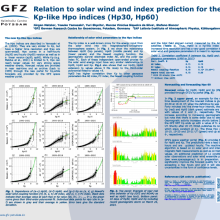Relation to solar wind and index prediction for the new Kp-like Hpo indices (Hp30, Hp60)
Jürgen
Matzka
GFZ German Research Center for Geosciences, Germany
Poster
The new Kp-like Hpo indices consist of the hourly Hp60 and half-hourly Hp30 and their linear versions ap60 and ap30 (for more information, see other abstract by Matzka et al.). They not only have a time resolution, which is higher than that of Kp, they are also open-ended. We compare the new indices to the open-ended Newell (2007) and Kan and Lee (1979) coupling function as well as other open-ended geomagnetic indices (auroral electrojet index AE and polar cap index PC) that indicate the energy transfer from the solar wind to geospace. We find that, firstly, the Hpo indices correlate slightly better with solar wind and geospace parameters than Kp itself. Secondly, the relationship between Hpo and the other open-ended parameters works follows simple polynomial functions also for Hpo > 9. A 72 hour lead time prediction of Kp and Hp60 is published and updated hourly on spaceweather.gfz-potsdam.de. The machine-learning algorithm is based on L1 solar wind and interplanetary magnetic field measurements as well as on historic index values. An additional prediction of L1 conditions from solar observations and solar wind ensemble predictions (see www.spacepager.eu) is in preparation. This will significantly improve the forecast quality for lead times exceeding a few hours and and it will also provide uncertainties in the form of confidence levels.

Poster PDF
Poster category
Geospace/Magnetosphere Research and Applications
Meeting homepage